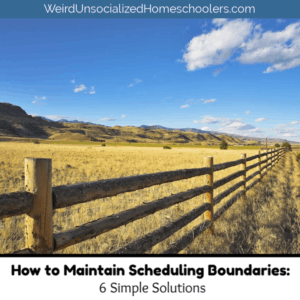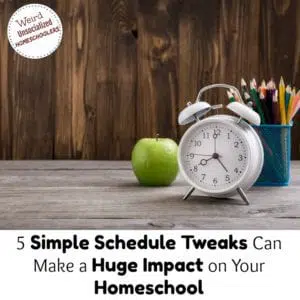Homeschool Schedules: 4 Important Details You Need to Think About
Thanks to its inherent flexibility, homeschool schedules are as varied as the families who make them. But there are four details you need to think about.
The first year we homeschooled, I ordered a book that shall remain nameless to protect the innocent. If you’ve homeschooled more than a decade or two, you probably know that one I’m talking about. It involved pretty little color-coded schedules – and waking before the sun.
Y’all. That book quickly wound up at the local used bookstore. It was so not me. Now, what about you?
You picked out your homeschool curriculum. You hashed out your school year calendar and penciled it in your planner. Now, to clear the next big hurdle – planning your day-to-day homeschool schedules.

It doesn’t matter if you’re the color-coded, scheduled-down-to-thirty-minute-intervals type or the lesson-plans-scrawled-on-post-it notes type, most of us need some sort of plan for our day. There is a lot of truth to that saying, “Failing to plan is planning to fail.”
So, how do you figure out your best homeschool schedule? The answer to that question is probably as varied as the homeschool parents asking it, but there are some details you need to consider.
Homeschool Scheduling Based on the Ages and Stages of Your Children
My daily schedule when I was homeschooling a 7-year-old with a 3-year-old and a 1-year-old along for the ride looked much different than it did when I homeschooled 11-, 13, and 18-year-olds.
My schedule completely changed again when I was down to only one high school student.
In the early days, I needed to consider attention spans and nap times. We did lots of hands-on, active things in the morning when the younger kids were wide-awake and requiring lots of mom time.
I saved schoolwork that required Brianna’s concentration and my availability (but not necessarily my one-on-one involvement) until after the younger two were ready for a quiet activity.
We completed activities that needed quiet focus and one-on-one time during the younger siblings’ nap times.
Later, when my homeschool classroom consisted of teens and tweens, our schedule was much more flexible. We usually tacked activities that didn’t require as much focused attention in the mornings before lunch when my night-owls are still working on getting coherent. Immediately after lunch, we hit the group subjects, such as history and science.
I saved hands-on activities, such as science labs, as the last thing we tackled together before the kids dispersed to do their independent work. They worked on those subjects, such as math and reading, at their own pace.
These days, my teen does the majority of her schoolwork after I go to bed at night. We have a shared Google doc for keeping track of lesson plans.
As you can see, the changing needs of children as they grow significantly impact homeschool schedules.
Planning Around Your Family’s Schedule
During our years of homeschooling, my husband has worked first, second, and third shifts. We’ve adjusted our schedule accordingly. Our favorite, by far, is his current regular first-shift schedule, but we appreciated the flexibility to start school after Dad left for work when he was on second. (We did not appreciate tip-toeing around all day when he worked third.)
If your family has an atypical schedule, take that into account when planning your homeschool day. Homeschooling means that that school doesn’t have to happen only between the hours of 8 and 3 – or even only Monday through Friday!
Plan a schedule that meets your family’s needs.

Scheduling Inspired by Your Family’s Natural Rhythms
If you’ve hung around here any at all, you probably know that we’re not that homeschool family who is up and finished with school by noon. If you are, that’s great! (And, I’m a little envious.) If you’re not, though, that’s okay.
One of my favorite things about creating homeschool schedules is that we can plan around our family’s natural wake and sleep times.
Some years, we worked toward an earlier start time (which many would still view as late). Other years we didn’t start school until after lunch. As teens, both of my girls preferred doing schoolwork in the wee hours of the morning (before turning in for the night). That’s when they were most productive.
My goal when planning our schedule is to let my kids work when they’re most productive and coherent.
So, whether you’ve got early birds or night owls or something in between, take your kids’ most productive hours into consideration as you plan your homeschool schedules.
Homeschooling Around Outside Classes and Co-ops
Two other details to think about when creating homeschool schedules are outside classes or activities and homeschool co-ops. When Josh and Megan were little, they took a homeschool music class. Because they were in two separate classes, the activity consumed a good portion of our Wednesday each week. I took that into account when planning my schedule.
There is no sense in putting more on the planner than you’re able to do. That just results in frustration for everyone.
For a couple of years, I was able to schedule Brianna’s art class during the time that we were out for music on Wednesdays. That worked perfectly. I planned our other subjects for Monday, Tuesday, Thursday, and Friday, leaving Wednesday open for music and art classes.
We rounded out our Wednesdays with nature study (at a nature center near the other classes), P.E. (with friends in the gym of the church where music class met), fine arts, and that much-needed socialization (for the kids and me!).
Thankfully, homeschooling allows for a flexible schedule that you can customize to meet your family’s needs. Whatever your scheduling style, most of us need some type of framework to ensure that we’re not so flexible that our kids suffer academically. As I have often told my kids, it doesn’t matter when you get it done, as long as it gets done.
Pretty color-coded schedules and waking before the sun are optional.
What considerations play into your family’s homeschool schedule?
You Might Also Like
Kris Bales is a newly-retired homeschool mom and the quirky, Christ-following, painfully honest founder (and former owner) of Weird, Unsocialized Homeschoolers. She has a pretty serious addiction to sweet tea and Words with Friends. Kris and her husband of over 30 years are parents to three amazing homeschool grads. They share their home with three dogs, two cats, a ball python, a bearded dragon, and seven birds.






I am sorry to see that you won’t be hosting List it Tuesdays any longer. I enjoyed them and I appreciate all the hard work you and Angie put in having them. Thank you both.
I definitely agree with everything you have said! Because of my son’s special needs, he had weekly appointments that we had to take into account. It was not only the time involved for the appointment but the fatigue factor after the appointment. I knew that he wasn’t going to come home and work on Math or English after therapy. However, he would be more willing to do History or Foreign Language (courses he enjoys). He is going to be a senior and has been exited from all therapies. We feel like we are going to have so much free time this year!
I know what you mean about trying to get back to school after a long day of appointments. That’s hard. I bet you’re both going to feel so free this year!
Great advice!! A schedule is so dependent on the stage of the kids and when they learn best. My kids are still early risers but maybe someday they will be night owls! Thanks for hosting the link-up 🙂
So I think I’m pushing the definition of “list” this week with my “5 Student Pictures” but I just love this link up! 😉 Thanks for hosting!! K
A big consideration here is the weather.. It gets really hot and humid in the summer, my older son gets overheated quickly so we do more inside during the summer time. The fall has beautiful weather for getting outside so we do more outside. Im very thankful for the opportunity to plan our “free time” in a way to take advantage of the nice fall weather. If we were stuck to having to have the traditional summer vacation the children would have a lot less time to enjoy Mother Nature.